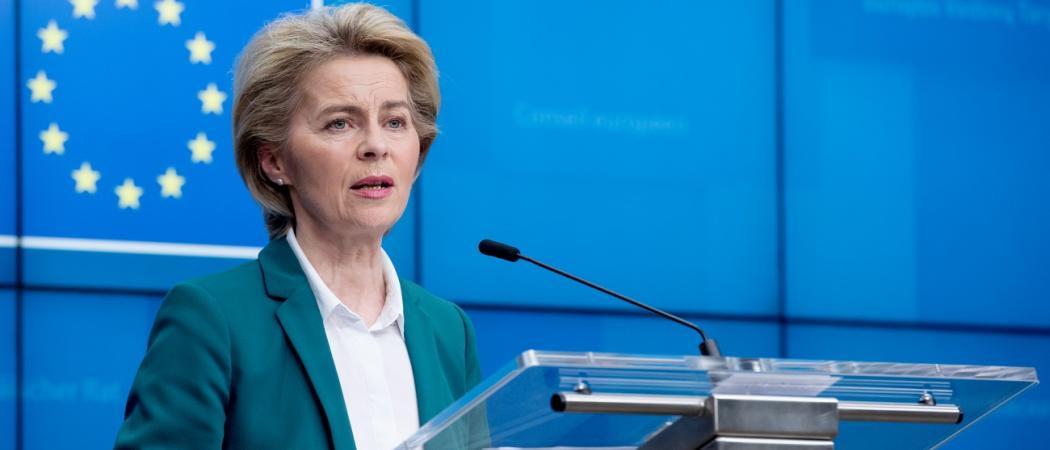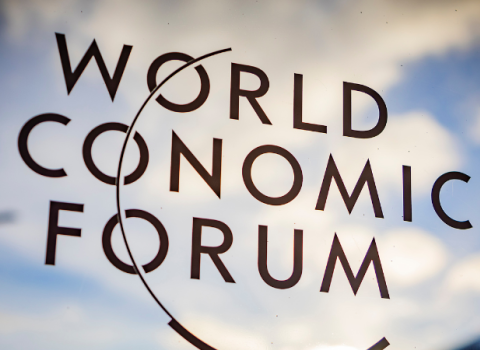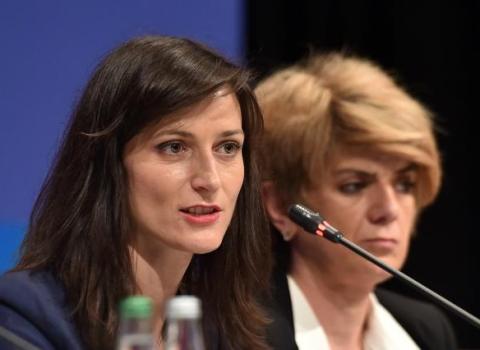Plan to infuse recovery money into green, digital and other research initiatives faces challenge from EU fiscal hardliners

EU Commission president Ursula von der Leyen. Photo: European Union.
The European Commission on Wednesday unveiled a bumper €750 billion emergency stimulus package to inject money into economies crumbling under the force of the COVID-19 pandemic.
“The damage from the virus is enormous. We need to raise our game to a completely new level,” said commission president Ursula von der Leyen. “The boldest measures are the safest for the future.”
The flood of new money, every cent of it borrowed by the EU, includes €500 billion in the form of grants and €250 billion in loans. The recovery lifeline sits on top of a revised seven-year EU budget. Together the schemes add up to almost €2 trillion.
The recovery plan, dubbed Next Generation EU, starts next year and will run until 2024. It pledges higher spending on the European Green Deal, the pre-crisis plan to make the continent climate-neutral by 2050.
Economy commissioner Paolo Gentiloni called the fund a "European turning point".
But many of the details remain to be fought over. Playing out in the background is a battle between France and Germany on one side – countries which together pushed for the €500 million in grants – and the bloc’s fiscal hardliners, the so-called ‘frugal four’ of the Netherlands, Austria, Sweden and Denmark, which oppose shared debt, and favour making loans instead.
Green recovery
Altogether around a quarter of the money in the recovery fund should flow to green stimulus projects, said von der Leyen.
A new financing vehicle, called the Strategic Investment Facility, will invest in the clean energy technologies, such as renewable energy and energy storage, clean hydrogen, batteries, and carbon capture and storage. The exact details are yet to be published.
A new partnership involving governments, universities and scores of businesses, called the Clean Hydrogen Alliance and modelled on a similar initiative to boost suppliers in the battery industry, will start in the summer.
The investment is part of a broad EU push to assert technological independence by creating an end-to-end hydrogen industry, owned by European companies. “We will be more mindful of [strategic] supply chains than we were before corona,” the president pledged.
Other proposals will help the auto industry through the crisis, while tying support to the production of electric cars and better batteries. There are also measures to install one million electric charging stations, and a “renovation wave” for rooftop solar panels, better home insulation, smart meters and more efficient windows and boilers.
“Whatever we do, shouldn’t do harm to our climate-neutral plan in 2050,” said the president, addressing those who fear a recovery by any-means-necessary could damage the environment.
Green criteria will be added to a new solvency support instrument for shoring up beleaguered companies in need of cash.
The plan also adds €30 billion to the €10 billion “just transition fund”, intended to help regions dependent on coal powered electricity generations to ditch fossil fuels.
A new “European Health Data Space”, meanwhile, will promote data exchange, presumably building on an EU effort to share research on coronavirus.
The main beneficiaries of the plan, as it stands, will be Italy and Spain, the EU member states that have been hit hardest by the outbreak.
“If we wait too long, we’ll have bankruptcies and unemployment. The cost of not being fast is way higher than we could afford,” von der Leyen said. The funds will be front-loaded over the next two-three years when they are needed the most.
“This is a quite significant plan and more importantly the commission is not using any wizard multiplier to reach the overall number [of spending],” tweeted Gregory Claeys, a senior research fellow with the Brussels-based Bruegel think tank. “In particular €500 billion in grants is significant, as it represents 3.5 per cent of EU GDP.”
The money behind all of this spending is debt. The commission can borrow money cheaply on the market thanks to its triple-A rating, using government guarantees as security. The borrowed money, which takes the EU executive into new territory, will be repaid over a long period – not before 2028 and not after 2058, the commission says.
It will later be recouped via higher national contributions of governments to the EU collective budget or via various new levies, such as a tax on plastic use.
Not another ‘lost generation’
The bill still has to wind its way through the Brussels sausage factory, stopping off at the European Parliament.
Both left and right flanks of the chamber broadly back the plan, though some individual MEPs argue that it’s insufficient. The pandemic has transformed the appearance of the parliament, with most officials and lawmakers covering their faces with surgical masks.
“Borrowing money is not my dream, but we see no alternative to invest now,” said Manfred Weber, the German MEP leading the centre-right European People’s Party.
“My message to the frugal four: your companies cannot be successful without a strong single market,” said Weber. “In 2008, we faced a lost generation. We can’t lose another generation.”
The Green group’s Ska Keller suggested Weber’s “best friend in Vienna”, a reference to prime minister Sebastian Kurz, is the main opponent of the recovery plan. “Let’s not repeat the big mistakes of the past, forcing countries into austerity,” the MEP said.
Money with strings attached is the acceptable way forward for Renew Europe, the liberal grouping in parliament.
“We will only support spending where the rule of law is a condition. [We don’t want to empower] politicians who don’t play by the rules,” said Dacian Cioloș, the group’s leader.
His message will have been directed at Hungary and Poland, two countries in the EU’s crosshairs for suspected violations of the rule of law.





 A unique international forum for public research organisations and companies to connect their external engagement with strategic interests around their R&D system.
A unique international forum for public research organisations and companies to connect their external engagement with strategic interests around their R&D system.